Doppler radar: Simrad VelocityTrack & Furuno DRS6A-NXT
Simrad has now officially joined Furuno and Garmin with a solid-state radar feature using the Doppler effect to instantly highlight targets moving relative to your vessel. “VelocityTrack” can be added to any existing open array Halo radar with the purchase of an unlock code, and it appears to be the most sophisticated version of the feature yet. Simrad also created a thorough VelocityTrack presentation that even explains technical subtleties common to all such Doppler radar features. Meanwhile, Furuno is now challenging the Simrad and Garmin solid-state Doppler open arrays with its new DRS6A-NXT…
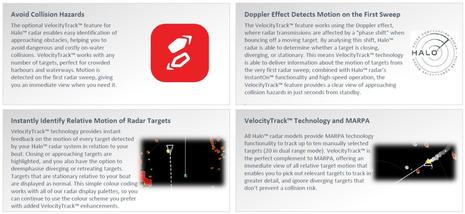 Here’s the Simrad VelocityTrack web page and note that this entry’s illustrations — which you can click much bigger — only include a fraction of what’s in the downloadable Information PDF. I’ve started with what seems like a clear explanation of the key ways VelocityTrack (and other Doppler motion highlighting features) can automatically and quickly improve collision avoidance.
Here’s the Simrad VelocityTrack web page and note that this entry’s illustrations — which you can click much bigger — only include a fraction of what’s in the downloadable Information PDF. I’ve started with what seems like a clear explanation of the key ways VelocityTrack (and other Doppler motion highlighting features) can automatically and quickly improve collision avoidance.
The technology is a pretty big deal in my opinion. In fact, I judged Doppler target speed discrimination, a “killer feature” when Furuno and Garmin first demoed it in early 2016, and I think that a fair number of boaters — experienced and inexperienced radar users alike — have come to agree. But good news travels slowly in our skeptical world, which is why Simrad’s informative marketing approach deserves attention.
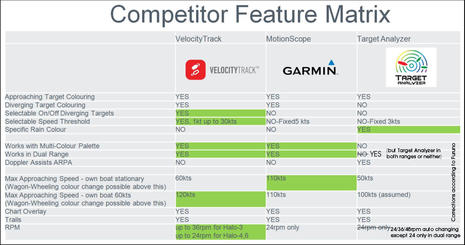 Especially valuable is this competitor matrix, which I believe to be quite accurate and complete (though competitor corrections are welcome). In one way it simply shows the strong similarity between all the Doppler target motion highlighting features, despite the confusion that each is usually referenced by its distinct brand name.
Especially valuable is this competitor matrix, which I believe to be quite accurate and complete (though competitor corrections are welcome). In one way it simply shows the strong similarity between all the Doppler target motion highlighting features, despite the confusion that each is usually referenced by its distinct brand name.
The matrix also (literally) highlights VelocityTrack differences, most of which are user controls. For instance, a Halo radar vessel can choose to only highlight targets moving in its general direction, like Furuno’s Target Analyzer, or to also show targets moving away, like Garmin’s MotionScope. A VelocityTrack user can also adjust the threshold target speed all the way from 1 to 30 knots (a control I’d particularly like to see on the Garmin Fantom 24 radome as its fixed 5-knot minimum misses some targets I’d like to see highlighted).
Update 1/6/2018: Furuno USA sent corrections that I added to the Competitor Matrix above. Their NXT radars can use the Target Analyzer feature in dual range mode, though it’s both ranges or none. And Target Analyzer does work with NXT auto switching between 24, 36 and 48 RPMs (though dual range is 24 rpm only). Also, an arguably missing line in the Comparison is the ability to trigger and thus highlight radar SARTS and RACONs, which is generally very hard for solid-state radars with their low transmit power and sometimes unusual frequencies. Furuno is claiming NXT SART and RACON detection up to about 1nm while I’m not aware that Garmin or Simrad claim any detection for their solid-state radars.
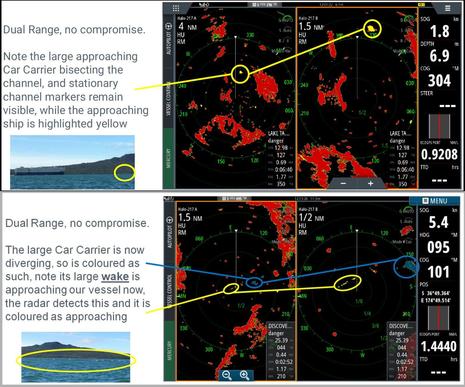 VelocityTrack also works in Halo dual range mode — true for Garmin Fantom too, but not Furuno NXT — and this screenshot series from the PDF illustrates how that can look in practice, along with an impressive Doppler trick I’ve seen myself from time to time. As expected, the big car carrier is brightly highlighted in yellow as it approaches, and then more dimly marked after it has passed its CPA (Closest Point of Approach). But since its wake is big enough to be targeted by the Halo radar and still approaching at more than threshold speed, VelocityTrack lights it up yellow – a little added situational awareness that might be darn useful.
VelocityTrack also works in Halo dual range mode — true for Garmin Fantom too, but not Furuno NXT — and this screenshot series from the PDF illustrates how that can look in practice, along with an impressive Doppler trick I’ve seen myself from time to time. As expected, the big car carrier is brightly highlighted in yellow as it approaches, and then more dimly marked after it has passed its CPA (Closest Point of Approach). But since its wake is big enough to be targeted by the Halo radar and still approaching at more than threshold speed, VelocityTrack lights it up yellow – a little added situational awareness that might be darn useful.
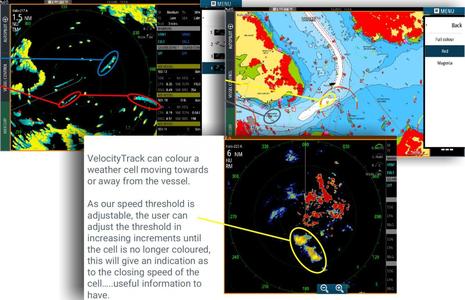 VelocityTrack seems adept at juggling colors so that the target highlighting stands out in whatever pallete you prefer, even with echo trails or overlaid on charts. Apparently it can also highlight rain cells, and it’s possible to approximate the cell’s speed by adjusting the threshold speed. But Simrad isn’t shy about declaring certain limitations of VelocityTrack or possible confusions Doppler motion highlighting can cause.
VelocityTrack seems adept at juggling colors so that the target highlighting stands out in whatever pallete you prefer, even with echo trails or overlaid on charts. Apparently it can also highlight rain cells, and it’s possible to approximate the cell’s speed by adjusting the threshold speed. But Simrad isn’t shy about declaring certain limitations of VelocityTrack or possible confusions Doppler motion highlighting can cause.
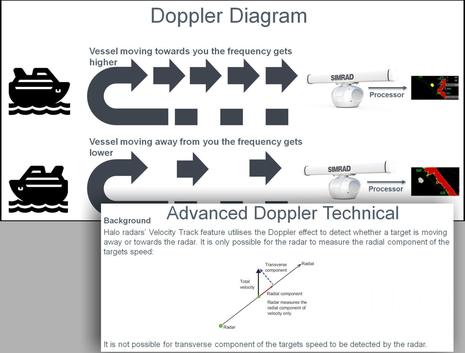 Now I suspect that many readers already understand how the Doppler effect slightly distorts the frequency of a returning radar microwave and that’s how motion can be detected on every sweep. And in my own experience the transitions that often happen seem fairly obvious, though useful. For instance, a crossing vessel like that car carrier above will highlight as approaching, then briefly go to stationary target color — because for a moment it is neither coming toward you nor moving away — and will finally highlight as diverging (except on Furuno screens where it remains unhighlighted, though quite possibly ARPA’d, which we’ll get to).
Now I suspect that many readers already understand how the Doppler effect slightly distorts the frequency of a returning radar microwave and that’s how motion can be detected on every sweep. And in my own experience the transitions that often happen seem fairly obvious, though useful. For instance, a crossing vessel like that car carrier above will highlight as approaching, then briefly go to stationary target color — because for a moment it is neither coming toward you nor moving away — and will finally highlight as diverging (except on Furuno screens where it remains unhighlighted, though quite possibly ARPA’d, which we’ll get to).
But now, thanks to Simrad, I better understand how the Doppler can only detect the radial component of the target’s motion, not the transverse component of the vector that is its true motion. While I still think that most users will intuit what’s going on, Simrad’s detail and diagrams really spell it out.
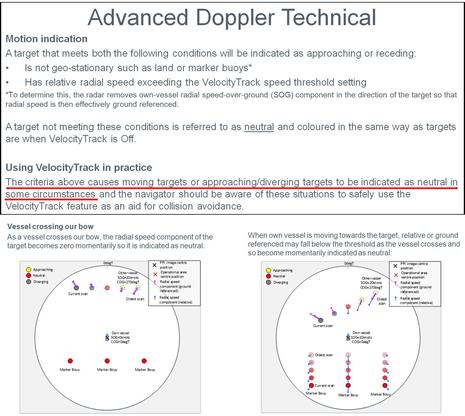 So those diagrams above show what VelocityTrack and similar Doppler highlighting does during crossing situations, and there are more diagrams for other situations in the PDF. Simrad also details how VelocityTrack and similar Doppler highlighting can get messed up when the target vessel and/or your own are moving at high speed. But, dang, “wagon wheeling” doesn’t happen unless a target is going at least 50 knots and you could be going that fast, too — see the competitive matrix — so I don’t see this as much of a real world problem.
So those diagrams above show what VelocityTrack and similar Doppler highlighting does during crossing situations, and there are more diagrams for other situations in the PDF. Simrad also details how VelocityTrack and similar Doppler highlighting can get messed up when the target vessel and/or your own are moving at high speed. But, dang, “wagon wheeling” doesn’t happen unless a target is going at least 50 knots and you could be going that fast, too — see the competitive matrix — so I don’t see this as much of a real world problem.
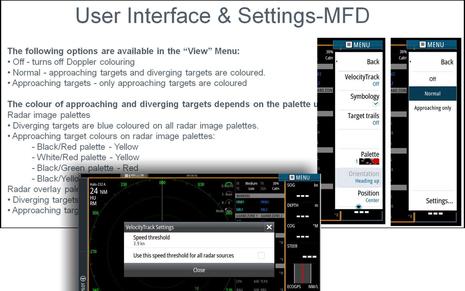 The Simrad presentation PDF also shows how the VelocityTrack controls have been integrated into their NSS/NSO interfaces as well as B&G Zeus, Simrad Commercial, and even the GO9/Vulcan9 entry level MFDs. You’ll also find detail about the VelocityTrack unlock procedure, which costs $500 and is a first in marine electronics, I think, but likely not the last. Some Halo owners may grumble — we’ve come to expect new features in free software updates — but note that the total Halo and unlock price is still quite competitive. In fact, I bet that most Halos get the VelocityTrack feature once more boaters experience the benefits.
The Simrad presentation PDF also shows how the VelocityTrack controls have been integrated into their NSS/NSO interfaces as well as B&G Zeus, Simrad Commercial, and even the GO9/Vulcan9 entry level MFDs. You’ll also find detail about the VelocityTrack unlock procedure, which costs $500 and is a first in marine electronics, I think, but likely not the last. Some Halo owners may grumble — we’ve come to expect new features in free software updates — but note that the total Halo and unlock price is still quite competitive. In fact, I bet that most Halos get the VelocityTrack feature once more boaters experience the benefits.
Furuno DRS6A-NXT
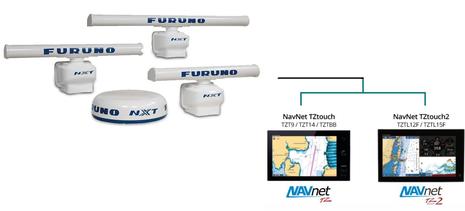 You may have noticed that Furuno’s Target Analyzer looks rather minimal in Simrad’s feature matrix, and that’s true, but kudos to Simrad for including the fact that only Furuno NXT solid-state radars use Doppler to assist with the ARPA features they call Fast Target Tracking and Auto Target Acquire. These are hugely valuable features in my experience, and my experience so far is only with the DRS4D-NXT radome.
You may have noticed that Furuno’s Target Analyzer looks rather minimal in Simrad’s feature matrix, and that’s true, but kudos to Simrad for including the fact that only Furuno NXT solid-state radars use Doppler to assist with the ARPA features they call Fast Target Tracking and Auto Target Acquire. These are hugely valuable features in my experience, and my experience so far is only with the DRS4D-NXT radome.
I’m pretty sure that the new DRS6A-NXT open arrays — with the finer horizontal beam width resolution always possible with longer antennas — can automatically acquire moving targets with even greater precision and maybe even faster than the NXT radome, and that’s saying something. I reviewed the DRS4D-NXT more than a year ago and am still awed by its performance, particularly the ARPA (which is so far only available in recreational radars from Furuno).
These days, in fact, I only enable Furuno’s Target Analyzer mode in very tight and busy harbors, because Doppler motion highlighting is so fast. But in most situations the NXT’s Doppler-assisted ARPA is quick enough at auto tracking that I turn off motion highlighting in favor of using the true color pallette. I don’t have to make that choice with the Garmin Fantom 24 I’ve also reviewed, so it’s Doppler MotionScope feature is always on, and that’s likely how I’d use VelocityTrack on a Simrad Halo radar.
And Simrad is correct that Doppler motion highlighting works very nicely with MARPA, giving you big hints about which targets are worth selecting with your finger or cursor for full tracking. So this Doppler feature is a good thing, and it’s great that Simrad is now offering what looks like a fully developed implementation. But I think that Doppler-assisted ARPA is an even better thing, and here’s hoping that all the solid-state radar manufacturers will eventually pull it off.
I’ll close with a Furuno TZT2 screen taken in October as a flock of snowbirds, Gizmo and I included, encountered a tug and barge in Chesapeake Bay. It might have been a stressful scene, particularly in dark or fog, but I was undistracted because every bit of data on that screen was generated without any intervention on my part. And since it was daylight, I can tell you that all those ARPA targets accurately represent the headings and speeds of the boats they’re tracking.
Note that the TZT2 can now show true echo trails, which in this case help to explain some targets that the ARPA hadn’t yet tracked, or didn’t think worth tracking, particularly the big barge behind Night Hawk. Note, too, that the TZT2 has neatly diagrammed where Gizmo and Night Hawk will experience CPA assuming we both maintain course. True trails are available on many modern radars, and I’m happy to report that I’m seeing automatic CPA diagrams like that on the Raymarine Axiom MFD with Quantum solid-state radar.
There’s a lot of very good radar and radar display available these days, and in this season of holiday cheer perhaps a tip of the glass to marine electronics is in order?


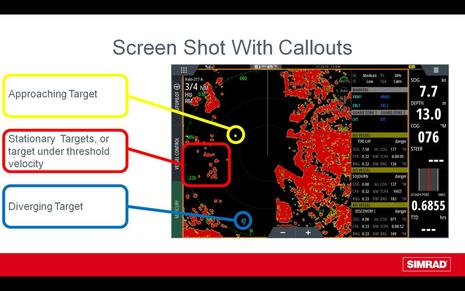
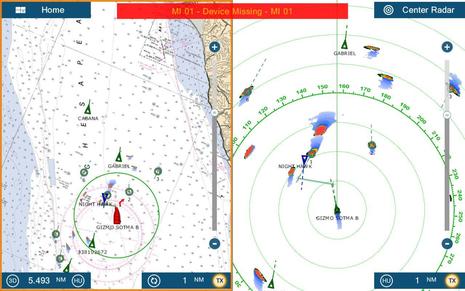
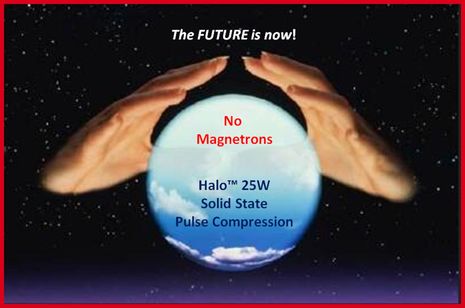

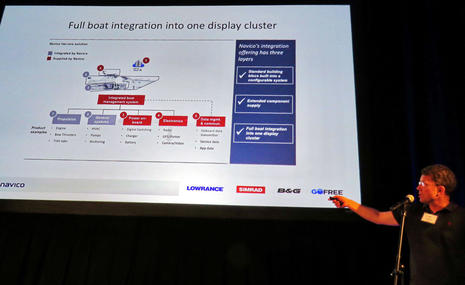
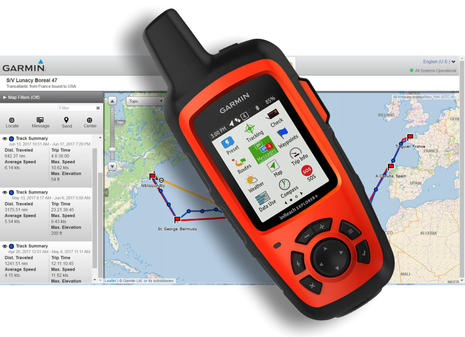







Ben,
In the last Furuno screenshot is Gizmo showing up as an AiS target because you have multiple AIS systems on the network? (I.e. transponder AND a receiver)
You’re observant, Howard, and also correct. The Furuno TZT2 is on a NMEA 2000 network with a Vesper XB8000 AIS Class B, but I was also running an Em-Trak B400.
All of these Doppler radar products are a massive improvement over the old high current draw magnetron units. I don’t think you can go wrong with any of them. In my case I bought the Garmin Fantom 24 right after Ben’s review to replace a Garmin HD24. After a sail from Chesapeake to Maine and back, sometimes in heavy fog, I found the new features outstanding. One suggestion is to take the time to understand and use the new features. Practice out on the water in good viz and daylight before that night time sail in torrential rain and commercial traffic. This has been one of the best electronic improvements I made in a long time.
Would love to see this for the Navico 4G radar. Huge installed base.
Looks really nice, Ben! Now I have to wait & see if Raymarine will follow suit.. 🙂
I am not convinced that magnetron radar will completely go away. Many complain the bird finding performance of solid state to be lacking. I am a huge believer in solid state radar and the accompanying signal processing that it allows.
If anyone at Furuno is listening- I would love to have a side by side real world comparison of a magentron radar and solid state radar. I will modify my radar mast accordingly.
Good idea, Howard, but there would have to be side-by-side comparisons in many situations and weather conditions, and you still wouldn’t know for sure that each radar was performing at their optimum.
Magnetron versus solid-state is a big issue since all the major manufacturers still offer both, and especially with Furuno because they introduced new open array magnetron radars just last year.
Read what this Panbo reader heard in the Furuno booth in Fort Lauderdale and maybe add your thoughts:
https://panbo.com/forum/2017/12/furuno-radar-nxt-solid-state-or-magnetron.html
A somewhat comical aspect of this is that for many years none of the brands except Navico had solid-state and some of the competing salespeople came up with solid-state put downs that they now have to live with.
I am up to the challenge…
Busy navigational challenges in Puget Sound and I will look for birds off the coast chasing Albacore tuna next summer.
Too my knowledge, no manufacturer has marketed their solid state vs magentron based on performance characteristics.
Magnetron Radar and Solid State radar are two different technologies.
A magnetron can provide a very high transmitted pulse for a short time and it has a fixed transmission frequency. There are magnetron frequency agility radar, but it is military equipment that cost a huge amount of money.
Magnetron radar has a fixed frequency but it also tends to spread unwanted frequencies (spurioses) and this makes it not easy to use doppler measurement as easily.
A solid state radar does not give as high peak power but can provide a long transmit pulse that can be varied in frequency and / or phase. With modern signal processing of the received signal, you get high resolution (i. e. pulse compression or CHIRP). A radar pulse that bounces against an object that is moving changes frequency (doppler effect) and this frequency change is detected in the receiver. If the frequency decreases, the item moves away from you and if the frequency increases, the object moves towards you. In order for this to be measured on objects moving very slowly (= small frequency shift), the transmitted signal must be very stable and very clean, ie there must be no spurioses.
Therefore, magnetron radar is not an option when it comes to these sophisticated equipment now available for pleasure boats.
Note that Furuno sent in some corrections to the Doppler target highlighting comparison that I added to the text and to the feature matrix table.
Also, another Furuno contact responded to Patrick’s comment by describing a commercial tuna fishing vessel that is using a 6AX with 6′ array and TZT2 12 MFD to see “individual birds (Man O’ War and large gulls) at 6-7 miles and flocks of 20-50 birds at 12-13 miles.”
“We completely acknowledge that solid state/Doppler/broadband is here to stay and Furuno will be in the mix too. With that said, magnetron radar still puts out more power and in fact the X-Class radar actually added nearly 50% more power output on target by virtue of PRR design.”
Haven’t seen this elsewhere. Simrad has released “radar control units” Dedicated LED backlit LCD monitors/controls in 9″ and 16″
http://www.simrad-yachting.com/en-US/Products/Radar/Simrad-R2009-Radar-Control-Unit-en-us.aspx
http://www.simrad-yachting.com/en-US/Products/Radar/Simrad-R3016-Radar-Control-Unit-en-us.aspx
Furuno also has some radars that are not available in the US that are similar.
http://www.furuno.com/en/products/radar/FAR-1416
http://www.furuno.com/en/products/radar/FAR-1426
Thanks, Howard! Those radars are already available on the Simrad Professional side, but it makes great sense to also offer them via Simrad Yachting because they’re based on the same Navico Operating System (NOS) and should integrate well with other Simrad gear us recreational boaters are familiar with.
https://www.navico-commercial.com/en-US/Products/Radars/Radar-Control-Units/
Any idea as to when will we see Raymarine’s answer to this. I’d pay for the upgrade but…. Strangely silent. Waiting…. zzzzzz
I would suggest you will see something from Raymarine at Miami this year.
Raymarine Doppler radar would be great to see, and I will be in Miami, but note that this is the first I’ve heard of it and I have no idea who Anonymous is. On the other hand, Ray and most of the other companies can be good at keeping secrets.
Given that I’m still waiting for Lighthouse III on my eS series chartplotters, I’m not holding my breath for doppler on the Quantum.
Cant wait to learn when doppler will be on 4G or Quantum radar systems.
I will be making a system purchase decision soon, and I just have to guess right I suppose.
Lighthouse 3 for eS is out now.
Thanks, anon. Lighthouse 3.3 discussion has been happening over on the Axiom/LH3 thread:
https://panbo.com/archives/2017/02/bam_raymarine_axiom_mfds_lighthouse_3_realvision_3d_sonar_flir_m100200_clearcruise.html
I got to briefly try it last week with Gizmo’s eS12 and Axiom7 and all went well. Both MFDs are now networking Navionics and C-Map charts, Quantum radar, FLIR M232 thermal cam, RayCam 220IP, and Axiom sonar. If anything, the eS seems faster than it was with LH2.
Jim,
Raymarine just released Quantum 2, which supports Doppler. http://www.raymarine.com/marine-radar/quantum2/
Navico 4G will never offer Doppler. Broadband (FMCW) doesn’t send out a fixed frequency so it cannot discern any Doppler shift. It seems logical that Navico is working on a Halo radome version in some form or fashion. 4G is now 7 years old, which is a long time in this market…
I guess Raymarine (and their Quantum customers) must feel a little unlucky, introducing Quantum just as Furuno and Garmin released models with Doppler in 2016. This means that Quantum 1 only lasted 25 months.
The original Quantum will stick around, I think, as solid and price competetive alternatives to Navico 3G and Garmin magnetron radomes.
But Quantum 2 is certainly interesting. Ben Stein and I got a demo of a beta version in Miami and will report. Got to see Simrad Halo Velocity Track live too.
Kees:
Doppler FMCW radar is indeed possible.
http://irep.iium.edu.my/31730/1/p.tale.2013.wsediono.Contribution230_b.pdf
I would hope to see something from them that wasn’t following the pack so to speak so it could be an interesting challenge, I’m sure if they wanted to port Halo to a dome they could have done so quite easily.
As an Engineer with 30+ years experience with FMCW radar I also want to point out that Kee’s reasoning that the “non-constant frequency” of FMCW waveform does not allow it to measure Doppler is indeed a fallacy. We used an FMCW radar at Ka Band (30+GHz) to measure the speed, angle and range of a MACH 1 projectile (1″ diameter) coming directly at the radar.
FMCW is also used extensively in Automotive collision avoidance radars and is very capable of range, angle and Doppler measurements. FMCW can also be used in other very sophisticated radar systems and should not be thought of as being crippled in any way.
Implementing FMCW Radar systems can be complex and takes some care but can be exceptionally capable. The Broadband radar could have been implemented better but was a good first effort for SIMRAD.
I have found this conversation very informative. Although mine is a belated comment I hope someone will reply. Seeing “individual birds (Man O’ War and large gulls) at 6-7 miles and flocks of 20-50 birds at 12-13 miles.” is impressive but is not what I am interested in. I have two main concerns:
1) small floats that mark (usually badly) nets near the coast at night;
2) ice floes bobbing up and down in a chop and sticking out of the sea surface by not more than a meter ( I am planning to sail in the Arctic);
Can anyone comment on how these new solid state radars would/are performing with regards to my two concerns above ?
Thank you